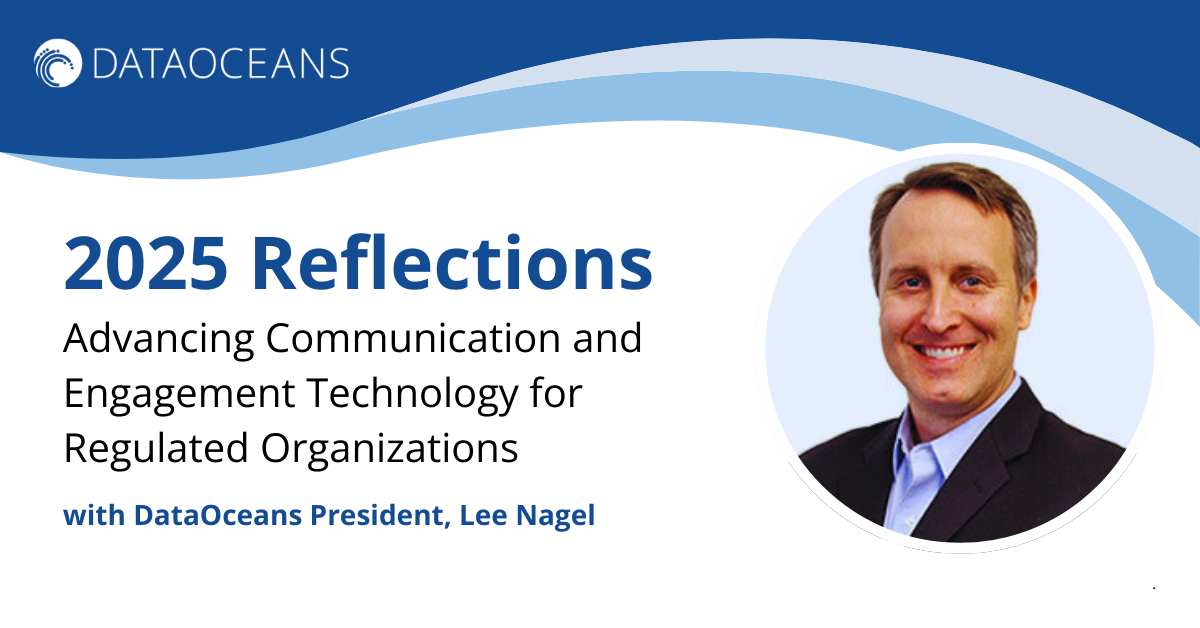What you need to know for successful member communications in 2021
Where Are Healthcare Payers Lagging at Communications?
Member Communications Management for Digital Transformation
CCM Improves Member Experience, Health Outcomes and Revenue
CCM for Healthcare is Comprised of Many Elements
Why Can’t Payers Build Their Own CCM?
The Benefits of CCM Hosted Managed Services
The impact of Covid has transformed the way organizations need to communicate with their customers. That has included healthcare payers who quickly pivoted to digital channels to connect with members. Post-pandemic, your members will continue to expect the communications you send to be immediate, customized and omnichannel.
When your organization can meet their expectations, members are more likely to remain engaged and loyal. That translates to healthier members who are more likely to follow health advice such as prescriptions compliance or testing. Better quality communications also help payers retain members year over year and save money on customer contact center support.
Is your organization poised to take advantage of this in 2021?
Where are Healthcare Payers Lagging at Customer Communications?
There are several common problems payers face when communicating with their members. Explanation of Benefits (EOBs) are unclear, resulting in calls to customer service and member frustration. It’s estimated that as many as 74% of consumers are confused by their EOBs and medical bills. EOBs are also graphically unattractive and lacking in customization, and so fail to engage members in ways that could promote better health outcomes. As we’ve seen over the past year, agility in communications is essential for health plans to communicate news and new offerings like telemedicine. Printed communications are too slow to meet these needs.
Healthcare payers tend to rely on an older generation of applications to produce their member communications. The data used by these applications is siloed in data sources that are unavailable for use by other areas of the organization without recourse to manual processes that can’t be scaled and that introduce the risk of errors. And for healthcare payers, the volume of data they hold continues to grow – an average of 878 percent since 2016, reaching close to nine petabytes each year. Communications functionality has been bolted onto older applications that were never designed to enable it. As a result, changes to communications are time-consuming and difficult – and introduce risk.
The solution to this untenable approach to communications is digital transformation. But organizations will not succeed at transformation if their solution is to purchase yet another point solution and retrofit it to work with existing processes. Boarding new customers on an outdated communications infrastructure will ultimately lead to higher attrition and negatively impact long-term growth. To truly digitally transform their business, organizations need to reengineer their processes across the entire enterprise, and that includes their member communications.
CCM: Member Communications Management for Digital Transformation
Today, payers can use a Customer Communications Management (CCM) solution to solve these communications problems. A CCM solution can drive digital transformation for healthcare payers by:
- improving member experience and reducing call volumes with better, more informative communications content and design
- enabling customer self-service, bill pay and preference choice with digital portals
- redesigning existing processes to make them digital-first and data-informed
- adding additional contact channels through which members can interact
- employing email and phone call analytics to optimize communications
- promoting wellness initiatives, prescription compliance, and disease management for better member health outcomes and cost savings
CCM Improves Member Experience, Health Outcomes and Revenue
Most large employers expect health plan costs to rise over 5% in 2021. They understand that digitalization can help save on costs and promote better health outcomes for members: “Many employers are avoiding health plan changes that impact employees this year, but they know managing cost must remain a priority,” says Tracy Watts with Mercer Consulting, about its National Survey of Employer-Sponsored Health Plans. “On the plus side, the momentum behind digital health innovation is driving towards greater efficiency, better health management and greater member satisfaction.”
Healthcare payers that onboard new members only to lose them at the next election period are wasting money and ultimately damaging their long-term growth. But payers that understand the needs of their members and deliver communications that are meaningful can reduce member attrition.
Member retention is important, but so is improving revenue. There are several paths to increased revenue from customer communications management. Data resulting from each communication touchpoint can be analyzed in conjunction with existing member data to reveal more opportunities to improve compliance and health outcomes. Better communications can also accelerate revenue streams. When members are confused by the EOBs they receive, it slows down payment cycles. A CCM solution that uses best practices to deploy clear-cut communications can speed time to payment.
CCM for Healthcare Payers Is Comprised of Many Elements
Customer Data Management. Payer organizations hold huge stores of member data, including names, addresses, phone numbers, providers, etc. Their core systems also save transactional data like account balances, dates opened and closed. They may also ingest unstructured data from streams like third-party providers or social media platforms. Much of this data is spread across different data sources and can’t be accessed in one place. All this data needs to be collected in a repository and normalized so it can be used for communications.
Content Management. Another part of the puzzle is content management functionality to display content that is customized based on data and business rules. This content includes assets like company logos, member details like explanations of benefits, and variable content that can be displayed in whitespace zones on documents. Content should be housed in a central data store where content changes and approvals can be captured and audited.
Communications Design and Composition. Communications design and composition functionality combines member data, graphic assets, messaging, templates and delivery preferences to create each communication touchpoint. Large organizations tend to have more than one composition tool, as different point solutions are purchased by different lines of business or print service providers or to meet new communications requirements. Graphic assets like logos may also be held in a variety of places, and may even be hardcoded into communications, making them difficult to locate and change.
Communications Delivery and Consent. Members should be able to receive communications across different channels, from printed mail and emails to SMS text messages. A CCM solution ensures that communications are delivered to members through their preferred channels by leveraging preference management functionality. Members can update their delivery preferences, consents to receive messages, even select language preferences via an online portal. By collecting member consents, healthcare payers can both demonstrate that they adhere to regulatory compliance and improve the member experience.
Archiving Member Communications. Communication touchpoints should be logged and archived for auditing and re-creation. Also required for regulatory compliance: logging data such as date and time sent for each communication delivered. This communications archive should be searchable online both by members via their portal and by customer contact center representatives who need to service member queries. In addition to the data collected and archived for each communication, the archive may also capture metadata on member interactions with communications, like email opens and clicks.
Reporting and Analytics. The lifecycle of a communication, from initial data ingestion to delivery should be captured for reporting and analytics purposes. Analytics can also be used to measure the effectiveness of communications, tracking metrics like opens and click through rates.
Why Can’t Payers Build Their Own Customer Communications Management Platforms?
It might seem that healthcare payers are more than capable of building and deploying their own communications management platform. These organizations support large-scale IT systems and technical teams. They may already own various CCM components that can be integrated with their existing applications.
However, building an inhouse CCM application is not an ideal solution for most organizations. Aggregating and normalizing the enormous volumes of member data for use in communications is a massive undertaking. Most organizations have significant IT projects on their plates. Building a communications platform, an application which lies outside of their core competencies, will impact their ability to deliver on other critical projects.
Payers that want to modernize their existing customer communications systems find that they are built with a variety of legacy components and point solutions that must be integrated into any new solution. Many of these cannot be completely integrated and will require ongoing manual processes that can be expensive to deploy and introduces risk. Payers will have to continue to pay for licensing and internal support to keep point solutions up to date.
Finally, even when an organization is able to build an inhouse solution, it cannot do so in a timeframe that enables it to keep up with customers’ changing expectations. Customer communications continue to rapidly evolve, and organizations don’t have the expertise, time and money to keep an inhouse CCM solution up to date.
Organizations can no longer rely on legacy platforms to generate communications. As this article notes: “Instead of using a back-end system to provide a front-end service, insurers are realizing that they must focus on implementing two-speed architecture; the back end focused on policy, the front end focused on the customer and each designed to communicate with the other in an open-looped system….Through this design, policy admin systems are put to use doing what they do best, while a more strategic, adaptable, omnichannel and personalized customer relationship management system can run in the foreground, delivering customers the content and experiences they want and driving up insurers’ satisfaction rates as a result.”
The Benefits of CCM Hosted Managed Services for Healthcare Payers
By comparison, a CCM solution purchased from an experienced vendor will conform to best practices in communications while deploying faster than a homegrown solution. Featuring user friendly interfaces, instead of IT- created ones, it can be owned and controlled by lines of business, instead of costly and busy IT departments. Adopting a hosted managed services CCM solution enables organizations to avoid large capital expenditures by switching to an OPEX model, eschewing long project timelines and ongoing IT support. A simple per unit price model can replace complex licensing while providing insight into costs and savings; in fact, communications improvements can pay for the solution in savings from print, postage and customer service support.
With the onset of the Covid pandemic, we saw a very rapid pivot to digital channels and the need for delivery of health information and updates to members in near real time. Digital communications will continue to change rapidly, pressuring organizations to add new digital channels and to improve the customer experience of existing channels. An omnichannel customer communications solution that centers on health plan members can meet their needs and those of the payers that service them.
What if you could improve your communications to increase retention and protect your investment in member acquisition? And what if you could realize efficiencies that would cover the cost of it all? Talk to us about how we’ve partnered with other payers to improve and enhance their member communications.




.png)
.png)